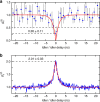Cross-polarized photon-pair generation and bi-chromatically pumped optical parametric oscillation on a chip
- PMID: 26364999
- PMCID: PMC4647848
- DOI: 10.1038/ncomms9236
Cross-polarized photon-pair generation and bi-chromatically pumped optical parametric oscillation on a chip
Abstract
Nonlinear optical processes are one of the most important tools in modern optics with a broad spectrum of applications in, for example, frequency conversion, spectroscopy, signal processing and quantum optics. For practical and ultimately widespread implementation, on-chip devices compatible with electronic integrated circuit technology offer great advantages in terms of low cost, small footprint, high performance and low energy consumption. While many on-chip key components have been realized, to date polarization has not been fully exploited as a degree of freedom for integrated nonlinear devices. In particular, frequency conversion based on orthogonally polarized beams has not yet been demonstrated on chip. Here we show frequency mixing between orthogonal polarization modes in a compact integrated microring resonator and demonstrate a bi-chromatically pumped optical parametric oscillator. Operating the device above and below threshold, we directly generate orthogonally polarized beams, as well as photon pairs, respectively, that can find applications, for example, in optical communication and quantum optics.
Figures







References
-
- Franken P. A., Hill A. E., Peters C. W. & Weinreich G. Generation of optical harmonics. Phys. Rev. Lett. 7, 118–120 (1961).
-
- Mukamel S. Principles of Nonlinear Optical Spectroscopy Oxford Univ. Press (1999).
-
- Assanto G., Stegeman G. I., Sheik-Bahae M. & VanStryland E. Coherent interactions for all-optical signal processing via quadratic nonlinearities. IEEE J. Quant. Electron. 31, 673–681 (1995).
-
- Dodonov V. V. ‘Nonclassical' states in quantum optics: a ‘squeezed' review of the first 75 years. J. Opt. B Quantum Semiclassical Opt. 4, R1–R33 (2002).
-
- Agrawal G. P. Nonlinear Fiber Optics Academic Press (2001).
Publication types
LinkOut - more resources
Full Text Sources
Other Literature Sources

